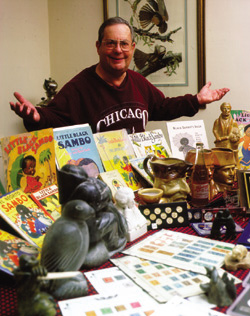Collective
efforts
>>
Collective
works
Chicago
wouldn't be Chicago if its graduates weren't bookworms, often
burrowing into the depths of highly specialized collections. (In
fact, most of our alumni collectors cited books as their "other"
passion. Typewriter enthusiast Richard Polt, for example, collects
works by eccentric Chicago novelist Henry Stephen Keeler.)
"What
comes to mind is the line I saw once in the Washington Post
book section about how you can tell if you have a serious biblioholic
problem if you come home late on a Friday or Saturday night and
lie and tell your wife you were out drinking at a bar because
you don't want to confess that you were really shopping at a used
bookstore," says David F. Mitch, AB'73, AM'74, PhD'82, associate
professor of economics at the University of Maryland at Baltimore,
who has amassed 7,000 volumes on economics and economics and social
history.
Though
Mitch professes to have recovered from his "compulsion"
when his daughter was born in 1996, he delightedly relates the
height of his passion, in 1994-95, when he picked up countless
volumes while on a Fulbright fellowship at the London School of
Economics. Some gems: a first edition of Principles of Economics
(1948), by Paul Samuelson, AB'35, part of a subcollection
that continues to the 12th edition ("one can chart through
the eyes of one of the most distinguished economists and textbook
authors of the 20th century the course of the discipline over
the last 50-odd years"); a first edition of John Maynard
Keynes's General Theory of Employment, Interest, and Money;
and Charles Frederick Roos's Dynamic Economics, one of
his 30 Cowles Commission monographs, including almost all those
authored by Chicago economists. Mitch also owns 150 of the 161
volumes of Harvard Studies in Business History-the collection
that started his collection.
Science
fiction is the genre of choice for Ross F. Bagby, AM'85, who has
125 video adaptations of Jules Verne stories and characters. "Video
collecting began as a game, to watch a Verne-based video each
week after reading or rereading the source book (e.g. the Harry
Hausen Mysterious Island after the original novel),"
writes Bagby.
After
exhausting the Verne reading list, Bagby changed the game in its
second year to watching any new Verne title each week. By year
three, the collection became self-propelling; fellow collectors
in search of obscure Verne titles were referred to Bagby and often
offered in swap rarities of their own. (Many referrals come from
his pal Brian Taves of the Library of Congress, co-author of The
Jules Verne Encyclopedia.) Now in its fifth year, the collection
continues to grow. This year's major addition was the Canadian-made
Secret Adventures of Jules Verne series, which aired in
the U.S. on the SciFi cable channel. Bagby's collection also includes
George Melies's A Voyage to the Moon (1902), several Russian-language
adaptations, and Verne-based episodes of Have Gun, Will Travel
(1960), Alfred Hitchcock Presents (1961), Josie and
the Pussycats (1972), and Muppet Babies (ca. 1985).
If
sci-fi is Bagby's bag, it's rags-to-riches tales for Michael C.
Dorf, AB'73. Dorf owns two-thirds of the 100-plus novels and biographies
written between 1864 and 1899 by Horatio Alger Jr. As a member
of the University's Blackfriars musical troupe, Dorf participated
in Luke Larkin's Luck, an original musical based on Alger's
Struggling Upward. "Since then," he says, "I
have roamed bookstores around the country with a list of titles
in my pocket."
Other
alumni confine themselves not only to a single author but to a
single work. For William M. Yoffee, AB'52, that work is Helen
Bannerman's The Story of Little Black Sambo, the once-popular,
later-reviled children's story of a little boy in India who gives
away his new clothes to tigers, only to recover them when the
bickering tigers melt into butter. The earliest copy in Yoffee's
collection is a second edition of the original British version.
He also owns about 75 U.S. versions and knock-offs, including
his most recent acquisition, a 1920s Sambo-themed primer.

"My
motive for building this collection was to put to rest the general
misunderstanding of this classic," says Yoffee, a children's
book dealer in Kensington, Maryland. "It is not about Africans
or African Americans, though some of the American illustrators
might lead one to believe otherwise." Among the most offensive
illustrations, he notes, were those created by famous illustrators
of other popular children's books: John R. Neill, who illustrated
most of the Oz books, and Johnny Gruelle of Raggedy Ann fame.
Sid
Huttner, AB'63, AM'76, has assembled 450 copies of Lucile,
a novel-length romance in rhymed couplets first published in 1860
by Owen Meredith (the nom de plume of Edward Robert, first Earl
of Lytton). One of many confirmed eBay users among U of C collectors,
Huttner has in the past two years purchased 150 copies from eBay
auctions, usually paying $15 or less, plus postage. ("Between
a quarter and a third of my total acquisitions budget goes to
the Postal Service!") The head of Special Collections at
the University of Iowa Libraries, he often speaks on Lucile
and the issues it raises for preserving late 19th-century print
culture.
Although
he says individual Luciles "don't have much meaning
by themselves," Huttner admits a fondness for an 1887 E.
& J. B. Young version, with its red plush silk binding and
celluloid onlay. "It has remarkable endpapers and is so fragile
that it cannot be possible that many copies survive. It is, however,
really rather ugly."
And
where would a bibliophile be without a bookmark? Sandra Ceraulo,
PhD'93, will never find out. She has 600 bookmarks, and when collecting,
she says, "I always try to take at least two"-one for
display in her bookmark baskets, and one to mark a passage or
recipe in her own eclectic collection of books and cookbooks.
Her favorite? A full-frame photo of a Frank Lloyd Wright window
for a Wright exhibition at Columbia University. She pocketed three.

![]()
